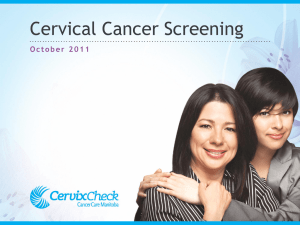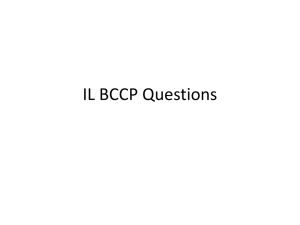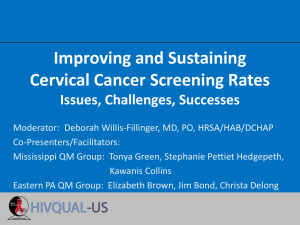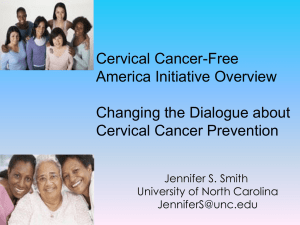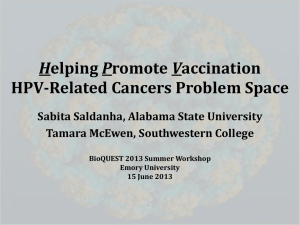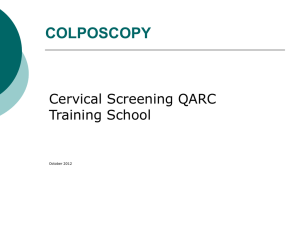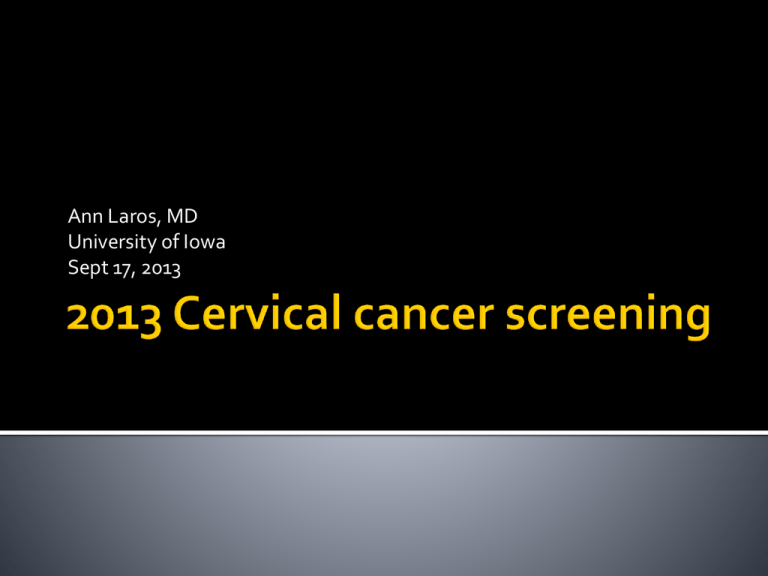
Ann Laros, MD
University of Iowa
Sept 17, 2013
Less is more
(Pap smears)
More is more
(Vaccinate all)
Source: NCI, 2005
Source: NCI, 2005
3
Cervical cancer was #1 cancer killer of
US women until 40 years ago
Pap widely implemented through 1970s
Currently in US
12,000 diagnosed annually
4,000 die annually
▪ Similar to US motorcycle fatalities
Most cancers are found in women who
▪ NEVER had a Pap (50%)
▪ OR had a Pap more than 5 years prior (10%)
More than 100+ HPV virus types
40+ types infect the genitals of men and
women
14 HR HPV types (oncogenic)
HPV 16/18 most common
HPV vaccines protect against these
▪ HPV2
HPV 16/18
▪ HPV4
HPV 6/11 and 16/18
Nano-valent vaccine in Phase 3 trials
Genital HPV is spread by genital to genital
contact.
HPV can be spread by same sex encounters.
Condoms decrease the spread by about 75%,
but do not prevent it.
No real test for HPV
Most infections resolve in 1-2 years
60-70% sexually active college students have HPV
20% risk with each partner
70-80% life time risk
HPV causes genital warts
1% young men/women get genital warts each year
10% life time risk
HPV causes abnormal Paps
10% of young women will have an abnormal pap each year
40% life time risk
Why?
Why so much change?
Did we really need to change?
Are they safe?
Are we going to miss cancers?
How do we do this and the Affordable Care
Act too?
Dr. Melik: You mean there was no
deep fat? No steak or cream pies or
hot fudge?
Dr. Aragon: Those were thought to
be unhealthy—precisely the
opposite of what we now know to
be true.
—From the 1973 Woody Allen
comedy “Sleeper.”
Develop evidence based cervical cancer
prevention guidelines to best serve women,
independent of cost
4,000 articles, 1.4 million women over 8 years
Stakeholders
ACHA, ACOG, AAFP, ACS
Nurse Practitioners in Women’s Health
Planned Parenthood, + 21 more
Recommendations were presented,
discussed prior to vote
66% agreement before acceptance
First do
no harm
NO Paps before age 21
Paps every 3 years age 21-29
Paps every 3-5 years 30-65
Normal Pap, every 3 years
Normal Pap and negative HPV, every 5 years
No change based on HPV vaccine status
No Paps after 65 or hysterectomy, if no CIN2+
Seriously
▪ Cervical cancer less than 21 is 1/1,000,000
Cervical cancer rates are low in young women
<21 year olds
21-25 year olds
1.4/1,000,000
1.4/100,000
When the risk of cancer is low, the risks of a
testing maybe higher.
Age of first pap
<20
EU country
Austria, Slovakia(18)
20
Germany, Greece(4.6),
21
23
25
30
Slovenia(16)
US(8.5)
Denmark(12.9), Sweden(8.7)
Belgium, Czech Republic,
France, Ireland, Italy(8.2),
Poland, Romania(29), UK
Finland (4.4),
31
http://eu-cancer.iarc.fr
Lithuania(25.6), Netherlands,
Spain
Bulgaria(25.8)
This is NOT new
The USPSTF recommends screening for
cervical cancer in women ages 21 to 65
years with cytology (Pap smear) every 3
years .
Grade: A Recommendation
We are not alone
Pap interval
Every year
EU Country
Austria, Czech Rep, Germany,
Greece (4.6), Slovakia (18)
Every 2 years
Every 3 years
Bulgaria (25.8)
Belgium, France, Italy (8.2),
Lithuania (25.6), Poland, Sweden
Every 3-5 years
US (8.5), Denmark (12.9), Ireland
(12.9), Spain (7.6), Sweden, UK
Finland (4.4), Netherlands,
Every 5 years
http://eu-cancer.iarc.fr
Romania (29)
The key is getting it done
▪ 50% of cervical cancers in the US occur in women who
have never had a Pap
▪ Finland starts at 30, Paps every 5 years—4.4
▪ Slovakia starts at 18, Paps annually—18
▪ US starts at 21, every year—8.5
▪ Has your mother had a Pap smear?
Two acceptable options for screening in this
population
PREFERRED
Pap and HPV Co-testing every 5
ACCEPTABLE
Pap every 3
No HPV testing
Reflex testing
Co-testing
No HPV testing
Under 25
Reflex testing
If Pap is ASCUS, then test for HPV
▪ If ASCUS, +HPV—colposcopy
▪ If ASCUS, -HPV—same as normal, follow-up in 3 years
Co-testing
If Pap is NORMAL, then test for HPV
▪ Some systems get HPV on all co-tested Paps, not usually
useful for LSIL and above
Pap after 30
Normal Pap
Repeat in 3 years OR HPV testing
▪ HPV negative
▪
▪
▪
▪ Repeat in 5 years
HPV positive
Repeat in 1 year OR
HPV 16/18 testing
HPV 16/18 negative
Repeat in 1 year
HPV 16/18 positive
Colposcopy
No sooner than age 30.
Pap based
Pap
Normal
Normal
OR
HPV
Negative
Positive
Neg 16/18
Pos 16/18
Action
Rescreen in 5 years
Repeat in 1 year w/ co-testing
Repeat in 1 year w/ co-testing
Colposcopy
Normal
LSIL or greater
ASCUS
ASCUS
No Co-testing
No HPV is done
Negative
Positive
Repeat in 3 years
ASCCP guidelines, no change
Rescreen in 5 years
ASCCP guidelines, no change
NEGATIVE PAP
LIQ CYTO
HPV HIGH RISK RESULT POSITIVE (A)
HPV 16 GENOTYPE
POSITIVE (A)
HPV 18 GENOTYPE
NEGATIVE
No screening following adequate negative
prior screening
Even if they have a new partner!!
“Adequate negative prior screening” not
defined
IF history of CIN2+, routine Pap for 20 years
▪ Every 3 years
Paps screen for cervical cancer, NOT vaginal
cancer.
Vaginal cancer is NOT common (840 deaths/year)
Exceptions:
Cervix remains (supracervical hysterectomy)
▪ Follow guidelines until age 65
CIN2+ including cervical cancer
No changes in frequency.
As of 2010, 20.5% women age 19-26 reported > 1 HPV
vaccine
This low vaccine uptake is a barrier to making
population based changes.
Iowa was among the worst
Look for vaccine related changes no sooner than
10 years.
Iowa Lags Behind Rest of US in HPV Vaccination
Iowa’s vaccination rate for genital human papillomavirus (HPV) is below
the national average, which itself has a low rate of compliance, according
to Philip Colletier, president for the Polk County Medical Society. A recent
CDC report showed that only 33 percent of children had completed the
three-shot sequence since the United States approved it in 2006 for girls
and in 2009 for boys. Colletier said that Iowa’s completion rate was only
21 percent and education was the key to increasing this rate.
Des Moines Register (08.23.2013)
Get the HPV vaccine, soon
Men can get the HPV vaccine
All men up to age 21
Some men through to age 26
Vaccinate your sons and daughters
Protect your daughters
Protect your sons
Vaccinate MSM
Based on “similar treatment for similar risk”
In addition to large population research studies, data from Kaiser in
California with 1.4 million women over 8 years.
Women of different ages have different risks.
<21
21-24
25-29
30+
Risk for CIN3+ in 5 yrs
Recommendation
5%
2-5%
.01-2%
.01%
Colposcopy
F/up 6-12 months
Pap in 3 years
Pap/HPV in 5 years
No paps under 21
If LSIL or ASCUS, ignore those done
If +HPV, ignore it
No endocervicals cells, no worries
Age matters
21-24 No HPV reflex testing
21-24 No colp for LSIL
No more 6 month follow-up
More HPV testing (over 30 and in follow-up of abnormals)
1. Unsatisfactory Pap—Repeat in 2-4 months
2. No endocervical cells—Normal, repeat in 3 yrs
3. ASCUS Pap—Repeat in one year (not 6 mns)
4. ASCUS, -HPV Pap—Normal, repeat in 3 years
5. AGUS—Colp. No HPV triage recommended
Represents inadequate cell collection
HPV testing requires adequate cell collection
as well.
Many HPV tests don’t have a fail safe for
inadequate vs not present.
Therefore can’t rely on NEGATIVE HPV in this
setting.
If unsatisfactory x2, immediate colposcopy
With liquid based paps, occurs in 10-20%;
higher in older women.
Review of KPNC, these women a have no
higher risk for CIN 3+
Including patients after treatment for CIN 2+
Remember: In 1950, 4 out of 5 doctors
recommended Camels
Repeat in one year
If ASCUS or worse—colposcopy
▪ 2 ASCUS leads to colposcopy, but they may be 1 year
apart, instead of 6 months
If normal—repeat in 3
Women under 25 (21-24) with ASCUS
PREFERRED: No reflex HPV testing; repeat in one
year x2.
ACCEPTABLE: Reflex HPV testing, OK*
*Neither ASCUS HPV+ nor HPV- women go to
colposcopy.
“Normal”
Repeat in 3 years (not 5)
If 65, this should not be the last Pap
▪ Repeat in one year
1. No colp for women under 25 with < LSIL
2. Moderate dysplasia can be followed in
“young women”.
Followed with colp in 6 months for up to 2 years
50% resolve
LSIL and HPV testing
Recommend reserve only for postmenopausal
Stigma of HPV
Anxiety of disease, follow-up
Cost and time for follow-up
Pain and injury from follow-up
Increased risks for preterm delivery
Recommendations for women sexually active
under 21
Folic acid daily
Chlamydia testing yearly
Flu vaccine annually
(HPV vaccine complete)
(Effective contraception)
(Exercise and healthy diet)
No Pap
1 in 8 babies delivers prematurely in the US
Too much Pap testing led to too many biopsies and
too many treatments and is one of the factors
contributing to preterm birth
Cervical cancer is not hereditary.
Most HPV infections resolve in 1-2 years
We are not looking for mildly abnormal cells, but
severely abnormal cells
On average it is 3-7 years from CIN3+ to cancer
Cervical cancer is a disease of younger
women, peak age 40.
Breast, colon cancers increase
Heart disease increases more
Regular exercise and a healthy diet
Is it safe to
Do a physical without a routine UA?
Give the pill without a cholesterol?
Give the pill without a Pap?
Place an IUD in a nullipara?
Eat margarine?
Do Paps every 3 years?
How well are we doing?
Quality assurance audits
Paps under 21
Colps/referrals under 25 (ASCH, HSIL, AGUS only)
HPV vaccinations men <21
Back to back Paps after 2013
Test
time
19 y/o presents for yearly and birth control
Sexually active since 15
19 sexual partners, HSV
Mother with cervical cancer
Last Pap 3 years ago
A. It has been 3 years, do Pap
B. No Pap, test for HPV
C. No Pap, test for Chlamydia
D. She is at high risk, do Pap
E. Chastity belt and Mom talk
Answer, C.
No Paps before age 21, SERIOUSLY
Chlamydia testing is recommended for all sexually
active women under 26 yearly
Sexually active women are likely to have HPV,
don’t test women under 30 for HPV
Cervical cancer is not heritable. It is caused by the
HPV virus
33 year old G2P2 for annual exam
No abnormal Paps
Pap today is normal
When is her next Pap due?
A. Next year
B. 3 years
C. 5 years
Answer, B
Paps every 3 years
If co-testing with HPV had been ordered and
HPV was negative, then 5 years
Take home lesson,
Unless your provider is George Clooney or
McDreamy , ask for HPV co-testing with your
Pap
20 year old
Pap: ASCUS, +HPV
Options
A. Refer for colposcopy
B. Repeat Pap in 6 mnths
C. Repeat Pap in 12 mnths
D. Repeat HPV in 12 mnths
Answer, C.
Repeat the Pap in 12 months.
Send the referring provider, up to date and
informative follow-up letter.
Set up a QI/QA survey in your own department.
STRONG recommendation for no Pap until age
21.
IF Pap obtained before 21, ignore unless CIN2+
50 year old P5
Last Pap 201o. No abnormal Paps
Hysterectomy for fibroids
When is her next Pap due?
A. Today, it has been 3 years
B. Every 5 years if HPV was negative
C. Never more. Thank Gosh for evidence based
medicine
Answer, C. Never more
Primary care providers ARE great
Modeled impact of target screening age on incidence of cervical cancer*
Target Age (years)
20–64
25–64
30–64
35–64
Reduction in CA Incidence (%) No. of Tests
84
9
84
8
81
7
77
6
Modeled using a 5-yr screening interval ,assuming a 70% sensitivity of the 1st screening test.
Data from IARC: Working Group on Evaluation of Cervical Cancer Screening Programs:
Screening for squamous cervical cancer. BMJ 293:659, 1986.
40 year old P2
Supracervical hysterectomy
Pap with HPV co-testing
▪ Pap= NORMAL
▪ HPV=POSITIVE
What do we do now?
A. Repeat Pap in one year
B. Repeat Pap in 3 years, it is normal
C. Refer for colposcopy
D. Refund her money, she didn’t need a Pap, she
had a hysterectomy
Answer, A. Repeat in one year.
Normal Pap
Repeat in 3 years OR HPV testing
▪ HPV negative
▪
HPV positive
Repeat in 1 year OR
We are looking for precancerous cells, not HPV
If HPV 16/18 positive, then COLPOSCOPY
Supracervical hysterectomy, leaves the cervix
25 year old
Pap: ASCUS, HPV negative
Options:
A. Refer for colposcopy
B. Repeat Pap in 6 months
C. Repeat Pap in one year
D. Repeat Pap in 3 years
Answer: D, Repeat Pap in 3 years
Question:
Does the risk of precancerous change in women with
ASCUS, HPV- warrant greater surveillance than normal
Pap, HPV-?No
Negative HPV is great.
Studies show no different in risk compared to
negative co-test (neg Pap and neg HPV).
21 year old
First Pap: LSIL
Based on 3/2013 guidelines
A.
B.
C.
D.
E.
Colposcopy
HPV testing, colposcopy of HPV+
HPV 16/18 testing, colposcopy if either positive
Repeat Pap in 6 months
Repeat Pap in one year
Answer: D, Repeat Pap in 1 year
In a young healthy woman, likelihood of
resolution in 1-3 years is high, 90%
Likelihood of developing cancer in this time,
low, low.
21 year old
First Pap: HSIL
PLAN:
A. Colposcopy
B. HPV testing, colposcopy if positive
C. HPV 16/18 testing, colposcopy if positive
D. Repeat Pap in 1 year
Answer, A. Colposcopy
High grade, is still high grade
Avoid HPV testing under 30
32 year old
LEEP for moderate dysplasia age 22
All normal Paps yearly since
Pap: Normal
Options:
A.
B.
C.
D.
Colposcopy
Repeat Pap in 1 year
Repeat Pap in 3 years
Repeat Pap and co-testing in 5 years
Answer: C, repeat Pap in 3 years
After treatment for CIN2+, there is an increased risk
for cancer that lasts 20 years.
Recommendation has been for regular/annual Pap
smears for 20 years. Now, Pap every 3 years for 20
years, even if this puts her greater than 65.
Initial clearance, co-test (Pap and HPV) at 12 and 24
months. If all negative, every 3 years for 18 more
years.
27 year old
Mild dysplasia on colposcopy
PLAN:
A. Repeat Pap in 6 months x2
B. Repeat Pap in 1 year
C. HPV testing
D. Cryo
Answer, C (preferred); (or A, acceptable)
HPV testing in one year
If POSITIVE , repeat colposcopy
If negative, return to routine screening
OR
Pap x2 6 months apart.
Colposcopy for ASCUS or greater
21 year old
Last Pap LSIL, 18 months ago
No follow-up w/ recommended colposcopy
Options
A. Refer for colposcopy
B. Pap with HPV testing
C. Pap only today
D. HPV testing only today
Answer, C
Colposcopy is no longer recommended for
women under 25 unless HSIL/AGUS.
▪ After 1 year, 70% of mild dysplasia is resolved
▪ After 3 years, 90% of mild dysplasia is resolved
Follow LSIL for 24 months in women <25.
Generally avoid HPV testing in women <30,
▪ except with ASCUS or in follow-up of known MILD
DYSPLASIA until age 30.
53 year old
Pap normal, no endocervical cells
Plan:
A. Repeat in 2-4 months
B. Repeat in 1 year
C. Repeat in 3 years
D. Repeat in 5 years
Answer: C, repeat in 3 years
If she had had HPV “co-testing”, 5 years.
2-4 months is for UNSATISFACTORY, meaning
not enough cells, not no endocervical cells
34 year old P5 with LSIL Pap
Colp adequate, Cx bx: Mild dysplasia
EndoPap: LSIL
Options
A. LEEP or Cone biopsy
B. Cryo or laser
C. HPV testing at one year
D. Pap x 2, 6 months apart
Answer: C (preferred); D (acceptable)
LSIL or CIN 1 in endocervix is NOT indication for
LEEP/Cone and should be treated like mild
dysplasia.
Treatment is NOT recommended for Mild
dysplasia
23 year old with history of an abnormal Pap
She thinks she had colposcopy.
She recognizes mild or moderate dysplasia, NOT
severe.
She does not remember cryo (freezing and
thawing), laser (burning with smoke
evacuator/vacuum), LEEP
She recalls a normal Pap last year, 2011.
Options (Records are not available)
A. Pap only today
B. Pap with HPV testing today
C. HPV only testing
D. Repeat pap in 3 years
Answer: No true answer
Based on her history recall and age, most likely
abnormal Pap is LSIL or ASCUS, +HPV.
IF colp was performed and no treatment was
recommended, either unremarkable or mild
dysplasia.
IF mild dysplasia, 2 Paps or one HPV test is
adequate follow-up.
MY answer
Ask your gynecologist or referring entity
A. Pap only today
24 year old
Humira for Rheumatoid Arthritis
Pap last year normal
Does she need a Pap this year?
A. Yes
B. No
Answer: No data. No recommendations
Probably yes, her medication weaken her
immune system and her ability to clear the
virus.

